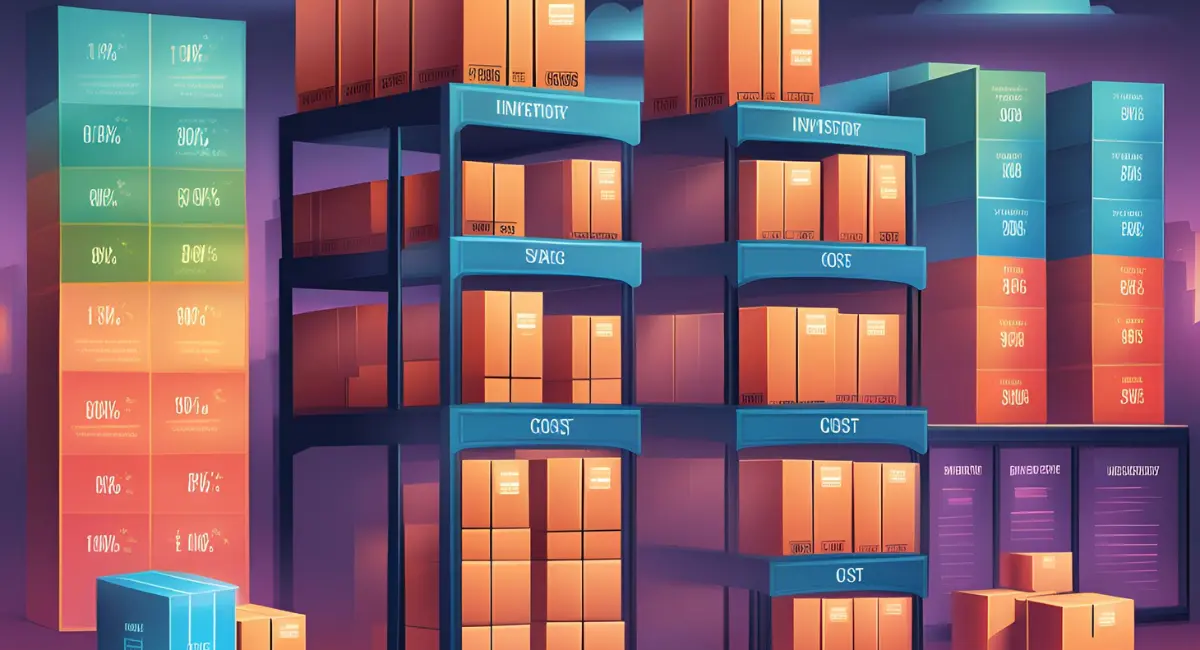Inventory holding cost, also called carrying cost, are the expenses that come with storing unsold goods. This includes costs like warehouse fees, insurance, and the money tied up in inventory.
If businesses don’t manage these costs well, they can add up and hurt profits. When inventory sits on shelves for too long, it not only increases storage costs but also uses up money that could be spent better elsewhere.
Because of this, it’s important to keep track of these costs to maintain good cash flow and improve overall business performance. Managing inventory holding costs is like running a supermarket.
The owner needs to make sure products don’t expire, get damaged, or become dirty. It’s all about balancing the costs of keeping items in good shape while trying to avoid waste. To protect profit margins, businesses must manage these costs carefully.
In this article, we will look at what inventory holding costs are and share some practical ways to reduce them.
Key Takeaways
|
Table of Contents

What is Inventory Holding Cost?
Inventory holding costs are the expenses businesses incur to store unsold products. These include warehouse fees, insurance, and security to keep goods safe. The longer inventory stays unsold, the more these costs accumulate.
Additionally, products may lose value over time, especially perishable or outdated items. Businesses also tie up capital in unsold stock, which could be used for other investments. This creates an opportunity cost that impacts financial performance.
Managing these costs effectively is key to protecting profit margins. By reducing excess inventory and improving storage practices, companies can lower expenses. This helps maintain steady cash flow and overall business success.
What Are the Differences Between Inventory Cost and Inventory Holding Cost?
In contrast, the term “inventory cost” refers to all expenses associated with acquiring and managing inventory. This includes the purchase price of the goods, shipping fees, taxes, and any additional costs incurred to bring the inventory to its current location. It reflects the overall financial outlay involved in acquiring products for sale.
In contrast, inventory holding cost specifically refers to the ongoing expenses associated with storing and managing inventory over time. This includes costs like warehousing, insurance, depreciation, and the opportunity cost of capital tied up in unsold goods. Holding costs can significantly impact a company’s profitability, especially when inventory turnover is low.
Key Differences:
- Scope: Inventory cost includes acquisition costs, while holding cost focuses solely on storage and management expenses.
- Timeframe: Inventory costs are incurred at the point of purchase, whereas holding costs accumulate over time as inventory remains in storage.
- Financial Impact: High holding costs can reduce overall profitability, making efficient inventory management critical for business success.
Example of Inventory Holding Cost
Understanding inventory holding costs is important like solving a puzzle, and it helps to know the specific examples that contribute to these expenses. Here are a few piece of common examples puzzle:
-
Storage fees:
Storage fees cover the cost of renting or maintaining a warehouse to store unsold goods. These expenses can include the rent or mortgage of the warehouse space, as well as utilities like electricity and water.
In addition to these, businesses often need to pay for climate control systems and general upkeep to keep the storage area in good condition.
-
Insurance premiums:
Insurance premiums are what businesses pay to protect their inventory from various risks, including theft, fire, flooding, or natural disasters. This protection ensures that if something happens to the inventory, the business can recover some or all of its losses.
The amount a company pays for insurance depends on the type of goods being stored and the location of the warehouse.
-
Cost of capital:
This refers to the financial burden of having money tied up in unsold inventory. When a business purchases products or materials, the funds used could have been invested elsewhere to generate income or grow the business.
The longer inventory stays unsold, the higher this opportunity cost becomes, as that capital is effectively frozen.
-
Inventory shrinkage:
Shrinkage refers to the loss of inventory due to theft, damage, or spoilage. These losses can happen while the goods are in storage or during handling and transportation.
Businesses must account for shrinkage in their financial planning, as it directly affects the overall value of their stock.
-
Obsolescence costs:
Over time, certain products may become obsolete or outdated. This happens when consumer preferences change, or when newer versions of a product enter the market.
As a result, the older stock might need to be sold at a discount or, in some cases, can’t be sold at all, leading to a loss in revenue.
-
Depreciation:
To add another piece to the puzzle, let’s look at a real-world example:

The manufacturer has ₱30 million worth of furniture sitting in the warehouse, which ties up money that could be used for other investments. Every month, the company faces a 1.5% loss in inventory due to shrinkage, which includes damage from handling and minor theft.
Additionally, as the manufacturer brings in new furniture designs, older stock can become outdated, lowering its resale value and increasing obsolescence costs.
This example shows how inventory holding costs can greatly affect a Filipino business’s profits, especially as these costs build up month after month.
Read More: Top Construction Inventory Management Software
How to Calculate Inventory Holding Costs
Sometimes, calculating how much inventory is being stored can feel overwhelming. Here’s a simple way to understand the steps involved in calculating inventory holding costs:
-
Add up total inventory costs
First, gather all the costs associated with holding your inventory. These include:
- Capital costs: The money spent on buying raw materials or inventory, including any financing fees and taxes.
- Warehouse costs: The expenses for storing inventory, such as rent, utilities, and insurance.
- Employee costs: Salaries, wages, and benefits of warehouse staff.
- Opportunity costs: The potential revenue you miss out on by storing slow-moving items or not being able to invest cash tied up in inventory elsewhere.
- Depreciation costs: The loss in value of products while they sit in storage.
- Inventory risk costs: Losses due to theft, damage, or products becoming outdated before they can be sold.
-
Calculate the total inventory value
To find out how much your inventory is worth, take the average value of the inventory you had during the period you’re looking at. You can do this by dividing the number of units sold by the average number of units you had in stock:
Total Inventory Value = Number of Units Sold / Average Number of Units on Hand
-
Figure out the inventory holding cost percentage
Finally, calculate the inventory holding cost formula by dividing the total inventory costs by the total inventory value, and then multiply by 100 to get the percentage:
Inventory Holding Cost (%) = (Total Inventory Costs / Total Inventory Value) x 100
This percentage will help you understand how much holding inventory affects your business and guide you in making better decisions to reduce these costs.
Are There Any Strategies to Reduce Inventory Holding Cost?
Reducing inventory holding costs is important for keeping a business efficient and profitable. Using targeted strategies can help cut unnecessary expenses and improve operations. Here are some simple ways to manage and lower these carrying costs:
1. Use just-in-time (JIT) inventory
First, only order products when you need them to avoid having too much in stock. This reduces how long items sit in storage and helps make better use of warehouse space. Furthermore, calculating safety stock and reorder points ensures you have enough to meet demand without overstocking.
If you want to use this method, please try to use HashMicro inventory platform, which streamlines the ordering process and optimizes inventory levels for maximum efficiency.
2. Work with third-party logistics (3PL)
Outsource your storage and labor to a 3PL provider to save on costs. They often have more efficient storage solutions, which can reduce expenses. Additionally, many 3PLs also offer software and tools to help you better manage your inventory.
3. Improve warehouse layout
Organize your warehouse better to save space and cut down on handling time. Upgrading shelving or adding automation can reduce labor costs and speed up how quickly orders are filled. A more efficient process means fewer mistakes and lower inventory costs.
4. Do regular inventory checks
Regularly check your inventory to find slow-moving or outdated items. Offer sales, bundle them with popular items, or donate them to reduce storage expenses and recover some of your investment.
Indeed, clearing these items reduces storage costs and makes room for more profitable products. These checks also help you improve your buying decisions.
5. Use inventory management system
Automate your inventory tracking with a system that gives real-time updates. This helps you avoid overstocking or running out of items. The cloud inventory management system also helps predict demand, so you can order the right amount and lower costs.
Optimize Your Inventory Management With HashMicro
HashMicro’s Inventory Management System is a strong ERP tool that helps businesses manage their inventory more effectively. It tracks inventory automatically, predicts future demand, and works with suppliers to cut storage costs and improve efficiency.
Moreover, HashMicro provides a free product tour and consultation to demonstrate how the software can be tailored to fit your business needs. This helps ensure a smooth setup, leading to better inventory management and savings on costs.
The product also includes some key features:
-
Stock forecasting
HashMicro uses advanced algorithms to predict future demand accurately. This helps businesses avoid overstock, lower storage costs, and maintain a healthier cash flow by analyzing past sales data. -
RFID warehouse automation
The RFID system tracks stock movements automatically, reducing manual work and errors. This speeds up processes and lowers labor costs while making better use of storage space. -
OCR for receiving
The OCR feature automates data entry when goods arrive, scanning documents to ensure fast and accurate updates. This saves time and reduces the costs tied to manual data entry. -
Warehouse stock optimizer
This tool ensures that each warehouse holds the right amount of stock based on its demand. By balancing inventory across locations, businesses can avoid overstocking and reduce storage costs. -
Quality control
The quality control feature helps identify and fix any issues early in the process. This prevents defective goods from piling up in storage, keeping unnecessary costs low.
-
Return management
This feature streamlines the process of handling returns, making sure items are managed efficiently. It reduces the space and costs associated with holding returned goods while keeping inventory records accurate. -
Stock reservations & reporting
Businesses can set aside stock for future orders and generate detailed reports. This allows for better stock management, preventing overstock and reducing storage costs.
Finding the right plan that fits your budget is key to boosting your business with HashMicro’s advanced solutions. Click the banner below to explore pricing options and find the best plan for your needs.
Conclusion
Effectively managing inventory holding costs is crucial for businesses looking to maintain profitability and optimize their operations.
By understanding the various expenses associated with storing unsold goods and implementing strategies to reduce these carrying costs, companies can improve their cash flow and overall financial performance.
Regular inventory checks, using technology for tracking, and strategic planning can make a significant difference in minimizing waste and maximizing resource utilization.
HashMicro’s Inventory Management System offers an advanced solution to help businesses streamline their inventory processes. With features like stock forecasting, RFID automation, and quality control management, companies can enhance their operational efficiency while keeping holding costs in check.
Finally, since you know they could drain your profit. It could be prevented by clicking the free demo and see how our solutions can revolutionize your business!

FAQ on Inventory Holding Cost
How much are inventory holding cost on average?
Inventory holding costs typically range from 20% to 30% of the total inventory value per year. This includes capital costs (10%-20%), storage (10%-15%), insurance (1%-3%), depreciation (5%-10%), and shrinkage. Costs vary by industry and operations, so accurate assessment is essential for effective management.What are the 4 inventory costs?
The four main inventory costs are:
- Purchase Cost: Total expense of acquiring inventory, including price, shipping, and handling.
- Holding Cost: Costs for storing inventory, such as warehousing, insurance, and tied-up capital.
- Ordering Cost: Expenses for placing and receiving orders, like administrative and transport fees.
- Stockout Cost: Revenue loss and customer dissatisfaction from running out of stock.
Is inventory holding cost fixed or variable?
Inventory holding costs can be fixed or variable. Fixed costs, like warehouse rent and insurance, remain constant regardless of inventory size. Variable cost, such as utilities, depreciation, and handling, change with inventory levels. Recognizing this helps businesses manage holding costs and optimize inventory efficiently.

























